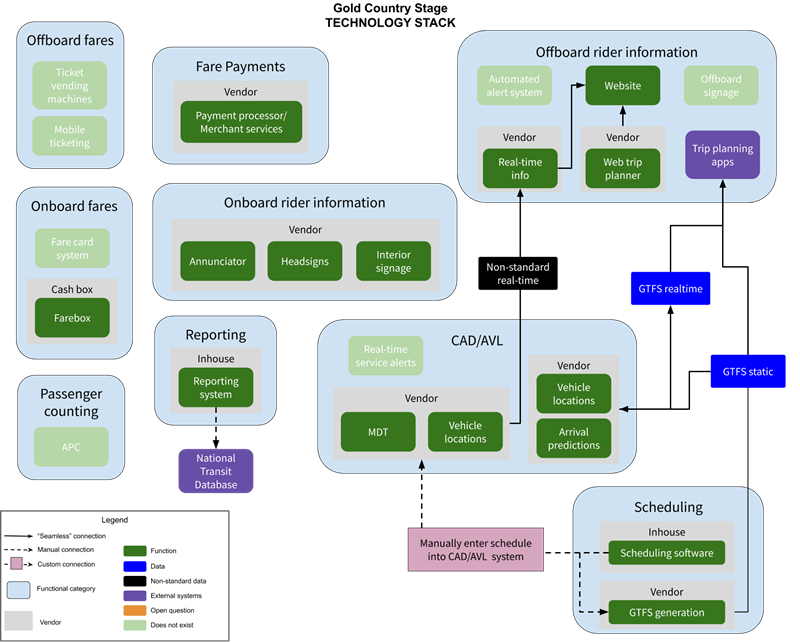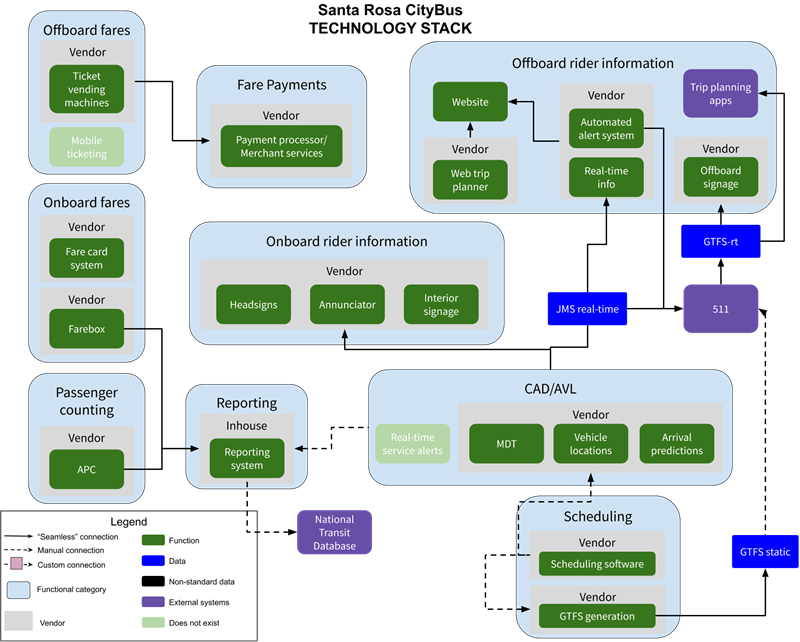Technology Stacks
There are several distinct hardware and software products that a transit agency can incorporate into their planning and service delivery (see Technology Components for a list). These products can have dependencies and overlap, depending on vendor selection and configuration choices.
The technology stack diagrams below illustrate how a selection of transit agencies in California have chosen and arranged these products into their technology stack. Each diagram includes the following.
- Functions
- Each function is provided by a component, such as Annunciation, Trip Planning, or Scheduling.
- Functions can be provided by a vendor or conducted within the agency (in-house).
- Most agencies support a selection of functions, and some functions are quite rare.
- Categories
- Groups of functions with similar operations.
- Connections
- Data often flows from one function to another.
- Some connections require manual intervention, while others are automatic (or "seamless").
- Data specifications
- When data is shared, it has to be formatted according to a known format so that the producer and consumer understand each other.
- Data specifications can be either:
- Open, meaning anyone can know and apply the format as a producer or consumer, or
- Closed/proprietary, meaning that a vendor's data can only be understood by products authorized or created by that vendor.
Gold Country Stage
Based in Nevada City, California, Gold Country Stage has eight routes and serves over 200,000 trips in a typical year.

Distinct features
- The agency has two vendors providing vehicle locations. One, using a non-standard format, provides data for the agency's own web-based planning tools. The other, using standard GTFS-RT, provides data to third-party trip planners.
- The agency creates its schedules manually, and keeps this data updated in three separate sources: its reference schedules, its GTFS-generator vendor, and one of its two CAD/AVL vendors.
- Onboard rider information tools are not integrated with the CAD/AVL information.
Porterville Transit
With nine routes and over 600,000 annual trips, Porterville Transit (which has since merged into Tulare County Regional Transit Agency (TCRTA)) serves a section of Tulare County in the western Central Valley.

Distinct features
- Real-time transit information is not available for third parties to consume. Riders only get this information through the agency's chosen vendor.
- Scheduling and CAD/AVL functions are each handled entirely by a single vendor, with no vendor overlap.
- Reporting requires manual integration with multiple sources, including the Automated Passenger Counting system.
Santa Rosa CityBus
Serving communities just north of San Francisco, the Santa Rosa CityBus has 15 routes and serves over two million trips in a typical year.

Distinct Features
- As part of the San Francisco Bay Area, 511 SF Bay, an external system, consumes Santa Rosa's static GTFS and CAD/AVL outputs to create standard GTFS-RT.
- Santa Rosa uses automated passenger counting, though data must be manually exported to be published to the National Transit Database.
- One vendor supports all components of the CAD/AVL system.
- Real time information viewed through the agency's website may be different than that seen in a third party application
- The CAD/AVL does not consume static GTFS directly, so in order for data consumers to have matching trip IDs in their static and real time feeds, these must be retroactively matched downstream.
Golden Empire Transit District
Operating in the southern Central Valley, around Bakersfield, GET Bus has 16 routes and serves over five million trips in a typical year.

Distinct Features
- As the largest agency in this selection, both in terms of routes and ridership, it is not surprising that GET would have technology to provide the greatest number of functionalities.
- All off-board rider information uses both GTFS and GTFS-RT.

